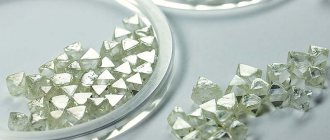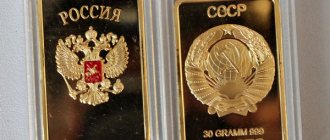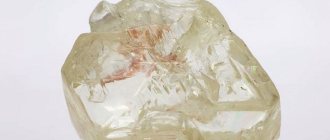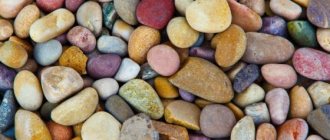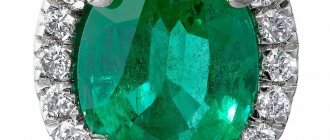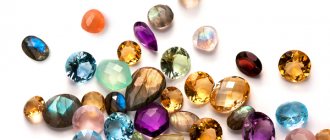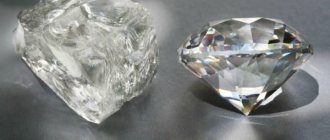In the 18th century, Peter the Great issued a special decree. According to this document, a collection began to be created in Russia, which was supposed to include the most exclusive and expensive valuables.
They automatically became the property of the state and ceased to be the property of the royal family. Nobles and nobles had to hand over precious insignia and state regalia. Before the war, the most expensive things were kept in the Winter Palace, in the Diamond Room. When the First World War began, all the treasures were transferred to the secret basements of the Kremlin. There they remained for some time.
In 1922, objects of jewelry were shown to the people in the Armory Chamber. And the collection received the official name “Russian Diamond Fund”. The basis of the Diamond Fund of Russia consists of 7 unique and luxurious jewelry, the value of which is indicated by fabulous amounts.
- This is interesting: Unique necklaces are masterpieces of jewelry art
Diamond "Orlov"
This precious stone sparkles on the scepter of Russian tsars. It has an amazing shape, reminiscent of an Indian rose. The Orlov diamond has 180 facets and weighs 190 carats. This crystal is the largest of all that have been found in India. There is a legend that this diamond is just part of a huge mineral, the total weight of which is about 400 carats.
The Orlov diamond was found in India in the 17th century. And before coming to Russia, he visited other continents. It was called "Derianur" and was placed on the head of an Indian idol, decorating it as a piece of jewelry. 100 years later, it was stolen by a soldier from France, after which the diamond was in the hands of the Persian Shah. When the ruler died, the precious crystal was stolen again and was brought to Russia.
Jeweler Lazarev transported the diamond across the Caucasus and sold it to Count Orlov, who already presented it to his beloved woman, Tsarina Catherine II. The Empress, to thank the count, named the diamond in his honor. It is this name that has survived to this day.
The Orlov Diamond is a surprisingly transparent crystal with greenish and blue hues. Its size is close to half a chicken egg, so the Orlov diamond is the largest in the collection of the Diamond Fund of Russia.
LiveInternetLiveInternet
Wednesday, August 28, 2013 16:55 + to quote book Having begun its formation back in the 18th century, by a special decree of Peter I, a unique collection of the most significant and valuable things was created in Russia, which were the property of the entire Russian state as a whole, and not owned exclusively of the royal dynasty. It was collected from unique jewelry of the secular nobility, precious order insignia, exquisite utensils and regalia of state significance. Expensive items from many generations of Russian Tsars before the First World War were kept in the Winter Palace, in a special Diamond Cabinet. At the beginning of the war, the famous valuable collection was urgently transported to the basements of the Moscow Kremlin, where it was stored for some time. In 1922, objects of decorative, applied and jewelry art, as unique exhibits, were exhibited in the Kremlin Museum of the State Armory Chamber under the name of the Diamond Fund of Russia, where they are exhibited to this day, stunning visitors with their indescribable beauty and sophistication. The so-called historical part of the Diamond Fund, along with imperial regalia, ancient orders and the best examples of jewelry of the 18th-19th centuries, includes unique precious stones known as the “Seven Historical Stones”, or “Seven Wonders of the Diamond Fund”. These are seven world-famous precious stones, especially large, beautiful and significant in their value - the Orlov diamond, the Shah diamond, a flat portrait diamond, a giant spinel, an emerald, a sapphire and a peridot. The Orlov Diamond is the most valuable and famous of the seven historical stones of the Diamond Fund. Since 1784, it has adorned the Imperial scepter of Catherine the Great. This is a delightful stone of an unusual shape, cut in the shape of an Indian rose, having 180 facets and weighing 189.62 carats. According to legend, the Orlov diamond is a processed natural fragment of a huge crystal weighing 400 carats, and according to another version, the original weight of the diamond decreased from 400 to 189.62 carats after it was cut into a diamond. The complicated history of this marvelous stone, which is considered the largest diamond mined in India, is interesting. Its first owner was Jehan Shah, a descendant of the great Mughal dynasty. It should be noted that the Grand Mogul Diamond, which also belonged to Jehan Shah and was subsequently lost, is often associated with the Orlov Diamond, and there is a version that the two diamonds are in fact the same stone. Whether this is true or not is not known exactly. Found in India at the beginning of the 17th century, it changed several owners before reaching Russia. The history of the stone is mysterious, and historians disagree. According to one version, it was set into a statue of Shiva in the famous temple of Seringapatam, but from there it was kidnapped by a French soldier, who then sold the stone to an English captain, who then sold it to a Jewish merchant, from whom Count Orlov later received it. According to another version, the diamond was stolen from the throne of Shah Nadir, into which it was set, and after passing through several hands it came to the Armenian merchant Lazarev, from whom Orlov received the stone. At first, according to legend, this stone was called “Derianur” and adorned the head of an Indian idol. Legend says that this diamond served as an eye for a statue of Brahma in the temple of Seringapatam (Mysore), and it was from there that a French soldier stole it at the beginning of the 18th century. According to another version, the diamond was stolen from the throne of the Persian Nadir Shah after his death in 1747. In 1768, the stone was purchased in Amsterdam by the Russian Count Grigory Orlov for 400,000 gold rubles as a gift to Catherine the Great; in 1773, it was presented by Orlov to Catherine II on her name day. The Empress ordered the stone to be inserted into her golden scepter. As a token of gratitude, Catherine gave the diamond the name of her faithful subject. The Orlov diamond is a crystal clear transparent stone with a slightly greenish-bluish tint. The size and shape of half a chicken egg, inserted into the imperial scepter, it is one of the most famous exhibits of the Diamond Fund.
The second in the precious collection is the no less famous and famous “Shah” diamond weighing 88.7 carats. It was found in the same place as the Orlov diamond - in the Golconda mines in India, in the 16th century, shortly before they were abandoned. This is a transparent stone of rare purity, with a slight yellowish tint, without cutting. Its natural shape is almost completely preserved, only in some places it is slightly polished. It is known that this diamond was worn as a magical talisman. According to Tavernier, in 1665, “the diamond was suspended from the Mughal throne and hung so that the one sitting on the throne could constantly see it in front of him.” On the stone there are three inscriptions in Persian, meaning the names of its previous owners and the corresponding dates in the Muslim chronology, based on the lunar calendar: first it was the ruler of the Indian province Nizam Shah, then Shah Jahan from the Mughal dynasty, the third was the Persian Shah Fath- Ali Shah, from whose hands he came to Russia. The Shah Diamond was presented by the son of the heir to the Persian throne as a gift to the Russian Tsar along with other valuable gifts in the hope of ending the conflict that was brewing in connection with the tragic events in Tehran. In 1829, the diamond was brought to Nicholas I by Prince Khozrev-Mirza as a ransom “in atonement” for the murder of the head of the Russian diplomatic mission A.S. in Tehran. Griboedova. It is believed that, captivated by the charm of the diamond, the emperor accepted the ambassador's gifts and forgot the Tehran incident.
The Diamond Fund also presents an amazing absolutely flat diamond weighing 25 carats and a total area of 7.5 square meters. cm, set in an exquisite gold bracelet, made in the Gothic style. This is a “portrait” diamond, under which a colored miniature of the portrait of Emperor Alexander I is inserted. This transparent stone is considered the largest portrait diamond ever used in the world. The diamond, together with a bracelet made to order in France, arrived in Russia in the 19th century. Now it is kept in the collection of the Diamond Fund among seven historical famous stones. The bracelet itself is a rare masterpiece of jewelry; a “portrait” diamond in an elegant gold frame inlaid with enamel and emeralds is a magnificent addition to the bracelet.
Another beautiful gemstone from the Diamond Fund is the magnificent bright red huge spinel weighing 398.72 carats, which adorns the symbol of the Diamond Fund - the Great Imperial Crown. The Great Imperial Crown, a marvel of jewelry art, was made in 1762 for the coronation of Empress Catherine the Great by court jewelers Georg Eckart and Jeremiah Pozier; Georg Eckart supervised the work and created the sketch and frame of the crown, and Pauzier was in charge of selecting the stones. The crown itself is made of gold in the form of traditional openwork hemispheres, decorated with a continuous scattering of diamond decorative flowers. The crown contains 4,936 diamonds weighing a total of 2,858 carats, shimmering with multi-colored rainbow sparkles, and 75 pearls. The weight of this most expensive crown in the world is almost 2 kg. And it is crowned with a noble red spinel, amazing in its rarity and beauty. The stone was purchased in 1676 from the Chinese Emperor Kangxi and brought to Rus' by the scientist and writer Nikolai Spafariy, who was in the diplomatic service under Tsar Alexei Mikhailovich in Beijing (China) from 1675 to 1678. This famous stone, for a long time mistakenly considered a ruby, roamed from one crown to another and originally decorated the imperial headdress of Elizabeth Petrovna. Such a large noble spinel of even color and ideal purity and transparency is the greatest rarity, and there is no equal in the world.
A beautiful Colombian emerald set in a brooch (Russia, late 19th century) is also one of the seven historical stones in the Diamond Fund’s collection. The size of the stone (weight 136.25 carats), the uniform distribution of the rich green color and purity make it possible to classify it as a unique creation of nature. The emerald is set in an elegant brooch made of precious metals, studded with diamonds. The stepped cut of the stone goes perfectly with decorative monograms and leaves made of gold and silver. This amazing stone was found and brought from Colombia in the 15th-16th centuries, and in the first half of the 19th century it came to Russia and was set into a brooch by an unknown jeweler.
Another of the seven historical stones of the Russian Diamond Fund is a beautiful large antique sapphire from Ceylon, which has preserved an ancient Indian cut. It was purchased by Russian Tsar Alexander II as a gift to his wife at an exhibition in London. The stone is set in an openwork gold frame of an exquisite brooch, inlaid with many small and large diamonds. This sapphire is considered the largest and most beautiful sapphire in the world. Its weight is almost 260 carats, the original cut is unique, and the amazing lilac-blue rich color combined with the transparency and purity of the stone amazes the imagination. In addition to its amazing color, the stone is also remarkable for its processing. It has more than 100 facets, and the diamond setting was chosen with extreme taste. The upper part of the stone is completely covered with small hexagonal facets, and rays of light, breaking on this multifaceted surface, flow in sparkling fountains in different directions, creating a pleasant soft play. Diamonds enhance the brilliance of this beautiful gem. The brooch was made in the middle of the 19th century; its stepped shape successfully hid the excessive thickness of the stone, enclosed in a high, light openwork caste. Unfortunately, almost nothing is known about the origin of this sapphire, and only according to legend, it also traveled a long way from India through Persia and the Caucasus before reaching Russia.
The seventh amazing stone in the unique collection of seven historical stones of the Diamond Fund is one of the largest peridots in the world, an olive green stone weighing 192.75 carats (peridot weighing 310 carats is kept in the Smithsonian Institution in Washington, and peridot weighing 146 carats is in the Geological Museum in London). This marvelously beautiful transparent and pure, like spring water, covered with a unique old cut stone, was found on the volcanic island of Zeberget in the Red Sea. The giant chrysolite has no equal in the whole world for its purity, transparency and beauty of color. The large, slightly convex upper platform is surrounded by stepped facets, while the reverse side of the stone is less conventionally cut and covered with a complex combination of numerous irregular quadrangular facets. The stone has an elongated oval shape with perimeter dimensions of 5.2 x 3.5 cm and reaches 1.05 cm in thickness. In the past, it was set in gold with thirty diamonds. Historians claim that this particular stone is the supposedly “emerald” through which the Roman Emperor Nero looked at the fire of Rome that he himself had caused. In the numerous facets of this precious stone, sparkling rays of light of all green shades are refracted from its depth. This natural wonder completes the collection of seven historical stones. Source
| Categories: | Gallery. Beauty will save the world. Legends and myths. The greatest in history. You should know this. The beauty of the world. Stories of betrayal Amazing things nearby Mysteries of nature. Find out the WHOLE truth! Stories from life Incredible, but true Unknown about the famous Secrets and mysteries of the Russian Empire Beautiful photos |
Tags:
precious stones the most famous stones in the world unknown about the known unprecedented miracle of nature
Cited 2 times
Like share
0
Like
- I liked the post
- Quoted
- 0
Saved
- Add to quote book
- 0
Save to links
Liked
0
Diamond "Shah"
The second most valuable gem in the collection. Perfectly transparent with a yellowish tint. The diamond is not cut, it has only been slightly polished. The weight of the Shah diamond is 88 carats. A special feature of this crystal are the inscriptions that identify its previous owners. The inscriptions are in Persian.
The first keeper of the diamond was the ruler of one of the Indian provinces, then there was the Mogul, and then the Persian Shah, after whom the sparkling mineral was already delivered to Russia. It was brought as a gift to the Russian Tsar after the tragedy in Tehran, and the incident was over. The king did not have the fortitude to refuse such beauty.
Diamond “portrait”
The exclusivity of this diamond No. 3 in the collection is its absolutely flat shape. Its area is 7 and a half square cm, and the crystal is inserted into a gold bracelet. The diamond was called a portrait diamond because of the color miniature - a portrait of Tsar Alexander the First. The diamond is completely transparent and is one of the largest portrait diamonds in the world.
The bracelet was made in France, and it was delivered to Russia in the 19th century. It is difficult to imagine a more exquisite decoration. Enamel and emeralds perfectly complement the extraordinary irregular diamond, and gold brings beauty to perfection.
Login to the site
Having begun its formation back in the 18th century, by a special decree of Peter I, a unique collection of the most significant and valuable things was created in Russia, which were the property of the entire Russian state as a whole, and did not belong exclusively to the royal dynasty. It was collected from unique jewelry of the secular nobility, precious order insignia, exquisite utensils and regalia of state significance. Expensive items from many generations of Russian Tsars before the First World War were kept in the Winter Palace, in a special Diamond Cabinet. At the beginning of the war, the famous valuable collection was urgently transported to the basements of the Moscow Kremlin, where it was stored for some time. In 1922, objects of decorative, applied and jewelry art, as unique exhibits, were exhibited in the Kremlin Museum of the State Armory Chamber under the name of the Diamond Fund of Russia, where they are exhibited to this day, stunning visitors with their indescribable beauty and sophistication.
The Diamond Fund includes seven historical, world-famous precious stones, especially large, beautiful and significant in value. The scepter of the Russian tsars is decorated with the delightful famous Orlov diamond, a stone of amazing shape, cut in the form of an Indian rose, having 180 facets, weighing about 190 carats and is considered the largest diamond found in India. Judging by the legend, the Orlov diamond is a natural fragment of a huge crystal weighing 400 carats. The history of this magnificent stone is amazing. Found in India at the beginning of the 17th century, it changed several owners before reaching Russia. At first, according to legend, this stone was called “Derianur” and adorned the head of an Indian idol. In the 18th century, the legendary diamond was stolen by a French soldier and for some time served as an insert in the throne of the Persian Shah. After the death of the Shah, the diamond is stolen again, then falls into the hands of the Russian jeweler Lazarev, who manages to smuggle the diamond across the Caucasus Mountains and sell it to Count Orlov, who presented the diamond as a gift to the Russian Tsarina Catherine II. As a token of gratitude, Catherine gave the diamond the name of her faithful subject, under which name it is kept today in the Armory Chamber. The Orlov diamond is a beautiful crystal clear stone with a slightly greenish-bluish tint. The size of half a chicken egg, inserted into the imperial scepter, it is the largest and most famous diamond of the seven historical stones of the Diamond Fund of Russia.
The second in the precious collection is the no less famous and famous “Shah” diamond, a stone of transparent clarity with a slight yellowish sheen, lightly polished and uncut. It weighs over 88 carats, and there are three inscriptions on the stone in Persian, meaning the names of its previous owners. First it was the ruler of the Indian province, then the eternal Mogul, and its last owner was the Persian Shah, from whose hands it came to Russia. According to historical information, the Shah Diamond was presented as a gift to the Russian Tsar along with other noble gifts as a sign of the end of the conflict that was brewing in connection with the murder of the Russian diplomat Griboyedov in Tehran. Captivated by the charm of the diamond, the emperor accepted it as atonement and forgot the Tehran incident.
The Diamond Fund also presents an amazing absolutely flat diamond weighing 25 carats and a total area of 7.5 square meters. cm, set in an exquisite gold bracelet, made in the Gothic style. This is a “portrait” diamond, under which a colored miniature of the portrait of Emperor Alexander I is inserted. This transparent stone is considered the largest portrait diamond ever used in the world. The diamond, together with a bracelet made to order in France, arrived in Russia in the 19th century. Now kept among the seven historical famous stones of the Diamond Fund. The bracelet itself is a real masterpiece of jewelry; a “portrait” diamond in an elegant gold frame inlaid with enamel and emeralds is a magnificent addition to the bracelet, bringing its beauty to perfection.
A particularly beautiful and valuable stone from the Diamond Fund is a magnificent bright red giant spinel weighing approximately 399 carats, set in the symbol of the Diamond Fund - the Great Imperial Crown. This miracle of jewelry art was made by master Pauzier in 1762 specifically for the coronation of Catherine the Great. The crown itself is made of pure gold in the form of traditional openwork hemispheres, decorated with a continuous scattering of diamond decorative flowers. The crown has about five thousand diamonds, shimmering with multi-colored rainbow sparks. The weight of this most expensive crown in the world is almost 2 kg. It is crowned with a noble spinel, an amazingly beautiful stone, the pride of the Diamond Fund. A faceted red stone of uniform color and ideal purity and transparency is the greatest rarity on the Great Imperial Crown, which has no equal in the whole world.
Among the other stones of the famous seven of the Diamond Fund, the gigantic rich green emerald weighing more than 136 carats, inserted into an amazing brooch made of precious metals, studded with diamonds, stands out for its particularly exquisite cut and design. The step cut of the emerald goes perfectly with decorative monograms and leaves made of gold and silver. This amazing, uniformly colored stone was found and brought from Colombia in the 15th-16th centuries, and in the first half of the 19th century it came to Russia and was set into an amazing brooch by an unknown jeweler. The transparent purity of one of the largest emeralds in the world allows it to be considered a truly unique creation of nature. It occupies a special place in the museum's exposition.
Another of the seven historical stones of the Diamond Fund of Russia is, inserted into an openwork gold frame of an exquisite brooch, inlaid with many small and large diamonds, a giant antique sapphire from Ceylon, having an ancient Indian cut. This sapphire is considered the largest and most beautiful sapphire in the world. Its weight is almost 260 carats, the unique cut surpasses any description with its originality, and the amazing lilac-blue rich color combined with the transparency and purity of the stone amazes the imagination. The brooch was made in the middle of the 19th century; the appearance of the wonderful sapphire in Russia approximately dates back to the same time. Unfortunately, almost nothing is known about the origin of this stone, only, based on legends, it follows that it also traveled a long way from India through Persia and the Caucasus before reaching Russia.
And the last miracle stone in the unique collection of seven historical stones of the Diamond Fund is the world’s largest olive-green peridot weighing over 190 carats. This charming, transparent and pure, like spring water, covered with an amazing cut stone was found on the volcanic island of Zeberget in the Red Sea. The giant chrysolite has no equal in the whole world in terms of purity, transparency and size. In the numerous facets of this precious stone, a radiance seems to emanate from the depths, as if the peridot itself was emitting light. This natural wonder completes the collection of seven historical stones.
In addition to them, the Diamond Fund of Russia includes many more exhibitions of precious orders, exquisite ancient weapons, the Small Imperial Crown, the imperial orb with a blue sapphire crowning it, many precious items and utensils, as well as huge collections of diamonds and diamonds. But in terms of beauty, rarity and value in the entire Diamond Fund, there are no stones similar to the seven famous historical stones. This is a real treasure and priceless asset of the Russian state.
Giant spinel
The entire precious gem is 399 carats. You can see the jewel in the symbol of the Diamond Fund. Spinel adorns the Great Imperial Crown. Pozier created the jewelry masterpiece in the second half of the 18th century. Just in time for the coronation day of Catherine the Great.
The crown is made of the highest standard gold. Openwork hemispheres contain scatterings of diamonds in the form of decorative flowers. Their number reaches a record 5,000 diamonds, whose play of light resembles a rainbow. The most valuable (expensive) crown weighs almost 2 kg. And in its very center a giant spinel shines. The crystal is called the pride of the Diamond Fund, since it has ideal parameters for transparency and purity.
- This is important: Gold 18 K – what standard
The most precious stones: TOP-7
Human interest in precious stones arose thousands of years ago. A variety of precious stones were adorned with protective amulets that protected their owners from diseases and evil forces. Stones emphasized status. Each stone has its own properties, each type of gemstone has its own unique characteristics, but now we will look at the most precious stones in terms of their value today. And let's start with the most expensive.
Red diamond
The most expensive of the entire family of diamonds and the most expensive of all the precious stones in the world is considered to be the red diamond. During the entire period of man's acquaintance with diamonds, only a few such diamonds were found, and all of them were small. The size of each of them does not exceed 0.5 carats. Gemologists consider a natural red diamond to be purple-red. The Argyle mine, located in Australia, is the only mine where colored diamonds are mined. And this production is extremely small, but the price of each of these gems is quite impressive. Stones weighing more than a tenth of a carat can only be found at auctions with a price per carat exceeding a million dollars.
There are only a few of the largest specimens of red diamond, and their size is less than 0.5 carats!
Grandidierite
And grandidierite was first found in Sri Lanka. It is also quite rare and has a greenish-blue, greenish-blue or bluish-green color. This mineral was described by Alfred Grandidier, a French explorer working in Madagascar. It is on the territory of this island state that these rare stones are mainly mined today. Today, there are approximately two dozen faceted Grandidierites, and their cost exceeds 30 thousand dollars per carat.
Padparadscha
The name of the padparadscha gemstone is translated from Tamil as “the color of the sunrise.” The historical homeland of these pinkish-orange sapphires is Sri Lanka, Tanzania and Madagascar. Today, this mineral can no longer be found in its natural form in Sri Lanka. Padparadscha is obtained by heating the corundum mineral, bringing it to the desired condition in a furnace. The last classic padparadscha (made without heating) was sold in Sri Lanka 20 years ago. Its weight was 1.65 carats, and the price was 18 thousand dollars. Padparadscha weighing more than 5 carats is now considered collectible; the price of each carat can reach up to 30 thousand dollars.
Jade
Jadeite, better known as imperial, is a green colored mineral. It has long been considered one of the most mysterious stones in the world. Today it is mined in Japan and China, Mexico and Guatemala, Upper Myanmar and Kazakhstan. It is also mined in the USA. On the world market, the most precious stones of this type, which are of high quality, are sold at a price of 20 thousand dollars per carat.
Diamond
But the most common mineral is the well-known diamond. A cut diamond, called a brilliant, is the most desired gemstone, the dream of many of the fair sex. Except Antarctica, all continents have its industrial deposits. A perfectly cut D color diamond now sells for $15,000 per carat.
Ruby
No less popular among admirers of precious stones is the ruby, famous for its shades of rich red color. The stones can be bright or dark red or have a violet-red color. Their popularity and the small number of mined specimens make the cost of the stones quite high. The price of a carat of a high-quality ruby can be 15 thousand dollars.
Paraiba
Blue tourmaline or Paraiba was discovered in the eastern Brazilian state of Paraiba in 1987. This very rare crystal has a bright blue-turquoise color and is the most expensive member of its group. The price per carat of such a crystal is 12-15 thousand dollars. And the price of some unique stones can be much higher.
The most precious stones: TOP 7 was last modified: September 25, 2015 by admin
Precious StonesMost
Emerald inlaid into a brooch
The rich color and size of the emerald turned it into one of the most valuable crystals on the planet. 136 carats of pure weight paired with diamonds and precious alloy turn the brooch into a real work of jewelers of the past. The emerald has a step cut that looks harmonious with monograms and gold leaves. A drop of silver adds piquancy to the decoration.
Emerald was brought from Colombia in the 16th century, but the crystal came to Russia only at the beginning of the 20th century. It is unknown who inserted it into the brooch, but this only increases its mystery.
Ceylon sapphire
A giant sapphire from Ceylon also adorns the gold brooch. The gold frame amazes with its light openwork, and diamonds of perfect purity complete the composition. Sapphire is distinguished by its cut, which was made by craftsmen of ancient India. And there is no more beautiful crystal in the whole world. And larger, because the weight of a Ceylon sapphire reaches 260 carats.
- This is good to know: Hydrothermal sapphire - advantages and disadvantages
The brooch was created in the 19th century, when the stone came to Russia. But nothing more reliable about the stone was ever found out. There are many speculations, but what is true is unknown. Legends say that his road was long and bloody, and he walked a difficult path from India to Persia to get through the Caucasus to Russia.
Bob recently had an experience where the Lord placed seven large precious stones in Bob's hands.
Each stone was larger than his hands could hold. All these stones were shiny, each a different color (one of the colors) of the rainbow. Bob asked the Lord what these stones meant and was told that they meant the seven eyes of the Holy Spirit of God, or the seven symbols of the Holy Spirit according to John 14.
John 14:26 “And the Comforter (Counselor, Helper, Advocate, Advocate, Strengthener, Supporter), the Holy Spirit, whom the Father will send in My name, will teach you all things. And he will make you remember (remind you) of all that I have told you.” (Enhanced translation).
The Holy Spirit is the only person of God to dwell on this earth. He brings us to the knowledge of our sin and the need for our Savior, the Lord Jesus Christ. When we call on the name of Jesus to repent of our sins, we are born again (again) and receive the Holy Spirit of God living in us. From this point on we develop the qualities or symbols of the Holy Spirit.
These qualities are: Advisor, Assistant, Intercessor (Intercessor), Advocate (Defender), Strengthening, Supporting. Let's look at each of them separately.
Comforter: Who among us cannot comfort another person in difficult times? Perhaps this is just a kind word to express God's love for his neighbor in his time of despair. Maybe it's a hug from someone who has just lost a loved one or perhaps lost their job. Being a comforter simply means putting the needs of others above your own.
Advisor: We all have the ability to advise others because we have the Wisdom of the Ages living within us. When we are mature in God's Word and walk in His divine nature, we can counsel others to return to righteousness and keep them from going down the wrong path in life. We gain wisdom through our failures in life so that we can help others avoid those mistakes.
Helper: The ministry of help is vital to the Body of Christ. The church cannot function without this ministry. Helping ministry is the lubricant that keeps the wheel turning. Greeting, parking, security, people who clean the sanctuary, etc. are just a few of the vital jobs that help the church function properly. Although they are generally unnoticeable, the church cannot function without them.
Intercessor: Who among us cannot pray? We are all called to pray for each other. Paul encourages prayer without ceasing (I Thess. 5:17). We can intercede for anyone, anywhere and at any time. In the spirit there is neither distance nor time.
Defender (Lawyer): There are enough prosecutors in the body of Christ. Too often we point the finger at others, condemning them, instead of defending the righteousness of the saints. We are called to be advocates, to plead for the innocent and those who have no voice.
Strengthening: Simply means strengthening another in times of need, whether physically, spiritually, financially, etc. We must strengthen the body of Christ, and become one, and not tear each other apart. “A thread twisted three times will not break soon.” When you strengthen your brother in fellowship with the Holy Spirit, there is a covenant made in heaven and earth.
(Eccl. 4:12) “And if one begins to overcome one, then two will stand against him: and a thread twisted three times will not soon break.”
Sustainer: God will never leave us or forsake us, He stands by us in every situation we face. We are called to stand with others in their difficult times. We can be their stability and remain steadfast in difficult times. We can hold up their arms to simply be their support, just as Aaron and Hur did to Moses in the wilderness.
(Exodus 17:11-12) “11. And when Moses lifted up his hands, Israel prevailed, and when he lowered his hands, Amalek prevailed; 12. But Moses' hands grew heavy, and then they took a stone and put it under him, and he sat on it, and Aaron and Hur supported his hands, one on one side, and the other on the other side. And his hands were raised until the sun went down. "
Testament of His Love
(Genesis 9:13) “I set my rainbow in the cloud, that it might be a sign of the covenant between me and the earth.”
These gems are a reminder of God's covenant of love. Each stone Bob received is one of the colors of the rainbow, and each one represents a different symbol of the Holy Spirit.
When the Holy Spirit is poured into the body of Christ, we become living stones in the hands of God. Therefore, all our work, our life is poured into the body of Christ, becoming a comforter, adviser, helper, intercessor, protector, strengthener and supporter. We are then able to meet the needs of others simply by discerning what the Holy Spirit shows us.
Chrysolite
Peridot weighs 190 carats, so it is considered a real miracle stone. The olive-colored crystal stored in the Diamond Fund is recognized as the largest representative of its group in the world, and its purity is compared to the purity of spring water. The cut of peridot is also amazing. The crystal was found in the Red Sea on an island of volcanic origin, Zeberget.
These precious stones are considered the most expensive and exclusive in the Diamond Fund’s collection, but besides them, hundreds of other jewelry are stored there, whose value for the country is limitless. And everyone has their own destiny and their own story.
The history of the seven great stones of the Russian diamond fund
Slide 1
The history of the seven great stones of the Diamond Fund of Russia Work of a student of class 11 “B” Seredenko Ekaterina Supervisor: Morgunova E.P. October 16, 2022
Slide 2
Diamonds. Their structure and properties Diamond is a transparent crystalline substance, the hardest of all natural substances. The hardness of diamond is due to the special structure of its crystal lattice. In it, each carbon atom is surrounded by the same atoms located at the vertices of a regular tetrahedron. This type of crystal lattice is called atomic. Physical properties: colorless; refractory; hard, but at the same time very fragile; does not conduct electric current and heat; burns in a stream of pure oxygen with a weak blue flame. A diamond is a cut diamond.
Slide 3
A Brief History of the Diamond Fund of Russia This is an exhibition opened in 1967 in the Armory Chamber of the Moscow Kremlin. The foundation's collection includes masterpieces of jewelry from the 18th to 20th centuries, as well as nuggets and precious stones of historical and artistic significance. The Diamond Fund collection was founded under Peter I, received most of the valuable exhibits during the reigns of Elizabeth Petrovna and Catherine II, and was replenished during the reign of the Romanovs. Over time, the location and name of the fund changed. After the October Revolution, the collection of the Diamond Room was transferred to the Moscow State Repository of Narkomfin. A significant part of the valuable items from the collection was lost during the mass sale of jewelry of the Romanov dynasty by the Soviet government. Since 1967, the collection has been replenished with unique stones from Russian deposits and works of modern jewelers.
Slide 4
Orlov Diamond A famous gemstone from India with a faint greenish-blue hue. It was found at the beginning of the 17th century in the mines of Kollur, before cutting it weighed about 400 carats and was a fragment of an even larger stone. in 1738, Nadir Shah captured India and took all the captured treasures to Persia, including the Orlov diamond. The gap in the history of the stone comes ten years after the assassination of the Shah in 1747. There are two versions of how exactly the stone came to Catherine II. The first is that the stone was presented to the empress by her favorite Count Grigory Orlov at a celebration on the occasion of her name day in 1773. The second is that Catherine II herself was interested in the diamond and bought it with money from the treasury. To avoid the indignation of the nobles and people and to hide the huge costs, she asked Orlov to help her with this and present the stone as her gift. In 1774, Catherine II ordered a diamond to be inserted into the pommel of the Imperial scepter. The length of the scepter is 59.6 cm, on the golden surface of the handle there are eight diamond edgings, the pommel is decorated with a golden double-headed eagle, small diamonds and.
Slide 5
“Shah” Diamond An immaculately pure gemstone weighing 88.7 carats, has a yellowish-brown tint, and is minimally cut. The shape of the diamond is an elongated natural crystal-octahedron, reminiscent of a beveled rhombic prism. The exact location of the diamond is unknown. According to one version, it was found near the Deccan Plateau, but because of its yellowish tint it was poorly valued by the Indians and sold to the south of Hindustan. Three inscriptions are engraved on the stone. The first, Ahmednagar, was made by the court jeweler of Sultan Burhan II, ruler of the Ahmednagar province, in 1591. Compared to the other two, this inscription is not distinguished by its expressiveness and complexity of execution, but its level of engraving is the deepest. The second, Mughal, was carved out in 1642 by Shah Jihan, ruler of the Mughal Empire. After the collapse of the empire, the stone ends up in Delhi, and from there to Persia, where in 1810 the third, Persian inscription was made. The Shah diamond was presented to Nicholas I by the Persian prince Khosrev-Mirza as a ransom for the murder of A. S. Griboedov during the defeat of the Russian embassy in Tehran on January 30, 1829.
Slide 6
Flat “portrait” diamond One of the seven famous historical gems of the Diamond Fund is an absolutely flat diamond, weighing 25 carats. It is believed that a flat diamond is a fragment from a larger stone. Its total area is 7.5 cm2. Interestingly, the diamond is completely transparent. Today, this unique stone adorns a bracelet made of pure gold, which was made by jewelers in the Gothic style. This royal decoration was made in the second quarter of the 19th century by special order in France, from where it was brought to Russia along with the diamond. Many jewelers recognize this bracelet as a masterpiece of jewelry art; it features a flat, unique diamond set into a beautiful, elegant gold frame inlaid with emeralds and enamel. The length of the bracelet is 20 cm. A colored miniature of Emperor Alexander I is inserted under the diamond.
Slide 7
Giant spinel Giant spinel weighing 398.72 carats is a unique dark red stone of exceptional purity and transparency, with an original oriental cut. This stone crowns the Great Imperial Crown. was made for the crowning of Catherine II in 1762 and became the fourth in a row; the stones for it were taken from the dismantled crown of Elizabeth Petrovna. The authors of the product are court jewelers Georg Friedrich Eckart and Jeremiah Pozier. The silver setting of the crown contains 4,936 diamonds weighing 2,858 carats and two rows (75 pieces) of large matte pearls weighing a total of 763 carats. The height of the crown with the cross is 27.5 cm, the length along the lower circumference is 64 cm, the weight is slightly less than 2 kg.
Slide 8
“Green Queen” Emerald The “Green Queen” emerald, weighing more than 136 carats, has a rich dark green color, step cut, and is surrounded by diamonds. The stone was found in South America in the mid-16th century. During the reign of Nicholas I, it was framed with a patterned belt, the design of which is made up of old-cut diamonds in a silver frame, alternating with leaves dotted with small diamonds. In 1913, the emerald was placed in the storage room of His Majesty's office along with the collection of the recently deceased Grand Duchess Alexandra Iosifovna, wife of Grand Duke Konstantin Nikolaevich.
Slide 9
Giant Ceylon Sapphire A giant sapphire from Ceylon, weighing 260 carats, set in gold and perfectly cut pure diamonds. The sapphire was found on the island of Sri Lanka (until 1972 Ceylon), cut in India, from where it came to Persia along with most of the treasures of the Diamond Fund. In 1762 the Imperial Orb was made. The weight of the orb is 861 g, the height with the cross is 24 cm, since 1797 the cross has been decorated with Ceylon sapphire.
Slide 10
Giant olive green peridot Peridot weighs 190 carats, so it is considered a real miracle stone. The olive-colored crystal stored in the Diamond Fund is recognized as the largest representative of its group in the world. The cut of peridot is also amazing. The crystal was found in the Red Sea on an island of volcanic origin, Zeberget. In the past, it was set in gold with thirty diamonds. Historians claim that this particular stone is the supposedly “emerald” through which the Roman Emperor Nero looked at the fire of Rome that he himself had caused. In the numerous facets of this precious stone, sparkling rays of light of all green shades are refracted from its depth. This natural wonder completes the collection of seven historical stones.
Slide 11
Materials used: https://ru.wikipedia.org/wiki/%D0%90%D0%BB%D0%BC%D0%B0%D0%B7%D0%BD%D1%8B%D0%B9_%D1% 84%D0%BE%D0%BD%D0%B4#.D0.A1.D0.B5.D0.BC.D1.8C_.D0.B8.D1.81.D1.82.D0.BE.D1.80 .D0.B8.D1.87.D0.B5.D1.81.D0.BA.D0.B8.D1.85_.D0.BA.D0.B0.D0.BC.D0.BD.D0.B5.D0 .B9 https://edufuture.biz/index.php?title=%D0%A3%D0%B3%D0%BB%D0%B5%D1%80%D0%BE%D0%B4_%28%D0%A5 %D0%B8%D0%BC%D0%B8%D1%8F_9_%D0%BA%D0%BB%D0%B0%D1%81%D1%81%29 https://yandex.ru/images/search? text=%D0%B0%D0%BB%D0%BC%D0%B0%D0%B7%20%D1%84%D0%BE%D1%80%D0%BC%D1%83%D0%BB%D0 %B0 https://yandex.ru/images/search?text=%D0%B0%D0%BB%D0%BC%D0%B0%D0%B7%D0%BD%D1%8B%D0%B9%20 %D1%84%D0%BE%D0%BD%D0%B4%20%D1%80%D0%BE%D1%81%D1%81%D0%B8%D0%B8&lr=21621
